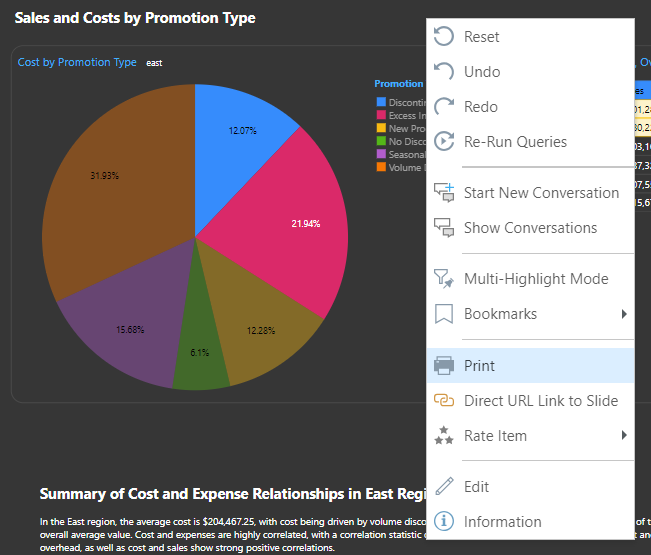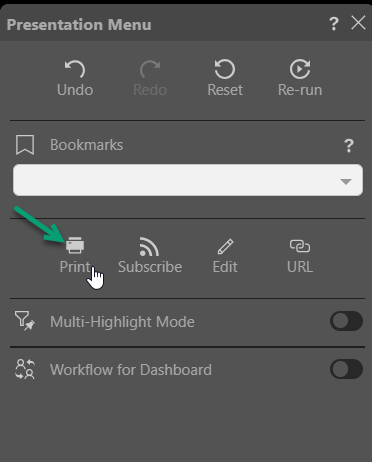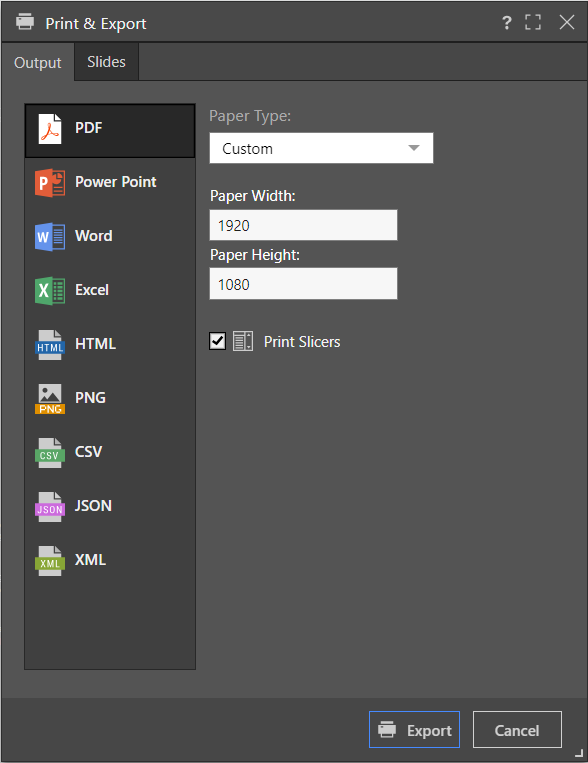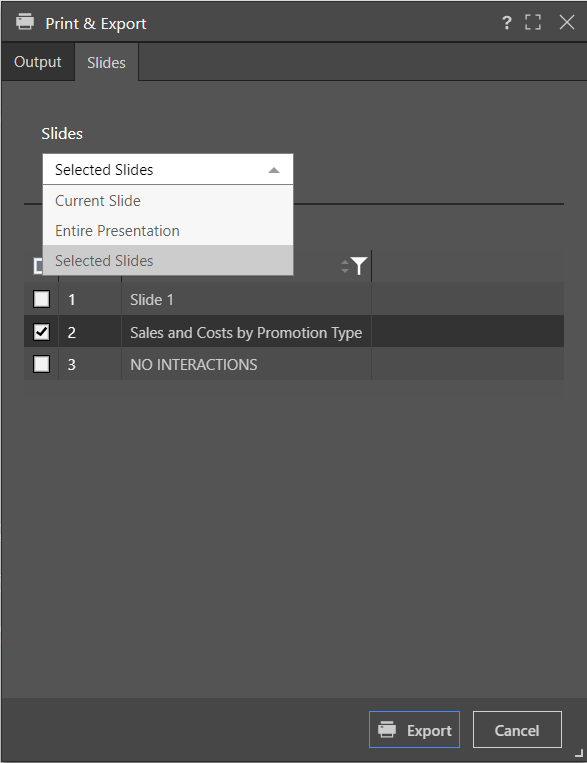To print a slide, or the contents of a whole presentation, you can either right-click the canvas of your presentation or open the Present runtime menu from the hamburger option and choose the Print option. When the Print & Export dialog opens, you can then select the format you want to export to (for example, PDF or JSON), set up some print settings, and indicate which slide or slides that you want to print.
Things to note about printing presentations:
- Printing a presentation is only possible when that presentation is launched at runtime. You cannot print your presentation when you are editing its content at design time.
- WYSIWYG: When you print a presentation, selections are applied as they are currently seen at runtime. This means that selections from slicers are applied, the visible tab from a mini-tab container is the only tab that is shown, text will not be wrapped with reference to a printing area, and so on.
- When printing from Present, you'll need to specify:
- The output format and appropriate page settings (Options) that you want to print.
- Which parts of the presentation should be exported (Slides).
Before you begin
It is important to note that any interactions that you have applied at runtime, such as drill down, dice, sorting, filtering, slicer interactions, and so on, will be reflected in the exported presentation.
If you want to export the presentation without any of these changes, you should open the Present runtime menu from the Hamburger option and click Reset before you export and print your presentation.
Accessing the Print dialog
Context Menu
Right-click the canvas in an empty space (without selecting a discovery or other content item):

Click Print on the context menu to open the Print & Export dialog.
Present runtime menu
- Click the hamburger menu at the top-left corner of the slide (green arrow).
- Click Print (green arrow) to open the Print & Export dialog.

The Present runtime menu opens to the left of the page.

Print & Export dialog
Output
Choose the output type and set the configuration options. Which options are offered depends on the output type. For example, Image Quality is offered if you're exporting to PowerPoint, Word, or PNG.

Note: Unlike discoveries and publications, you cannot export a presentation to the job spooler.
The following options can be selected when exporting your content for print:
- Paper Type: (PDF, Power Point, Word, HTML.) Select the paper size that you want to print to. If custom is selected, you will need to provide paper height and width settings.
- Image Quality: (Power Point, Word, PNG.) Select whether to incorporate images at low, medium, or high quality.
- Remove value based filters: (CSV, JSON, XML.) Where a value-based filter has been applied to data, select this option to export the entire dataset, rather than only the filtered values.
- Show title and breadcrumbs: (Excel.) When your spreadsheet is generated, the title appears in row 1, and the breadcrumbs appear in row 2. Both are as set at the time of export. For more information, see Print and Export.
- Print Slicers: (PDF, Power Point, Word, HTML, PNG.) Print a graphical representation of a slice if it's on the canvas:
- If this option is selected, the slicer visuals are printed with their current selections.
- If this option is disabled, on-slide slicers will not be shown in the exported or printed presentation, but interactions from the slicers are reflected in the output discoveries.
Excel options
When exporting to Excel, there are some size limitations which could result in very large files being exported in the CSV format instead of Excel. Click here for more information.
Slides
On the Slides tab, select the parts of the presentation you want to print:
- Current Slide: Export the slide currently being viewed.
- Entire Presentation: Export the entire presentation.
- Selected Slides: Specify which slides you want to export. If this option is selected, a list of slides is shown for the user to pick from:

Data Source Authentication
If you’re using Windows Authentication or SAP Logon Tickets to connect to your data source, you may be prompted to enter Authentication credentials when saving your changes.
- Click here to learn more about Data Source Authentication.